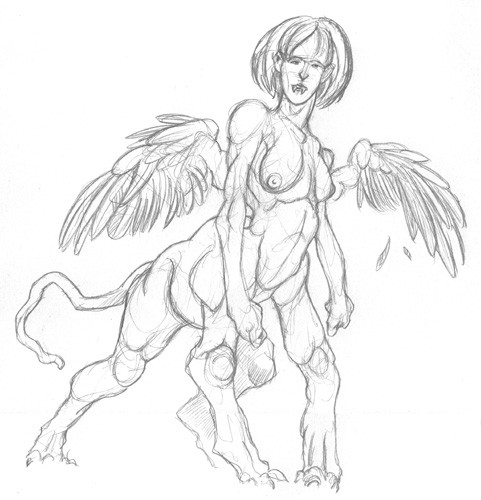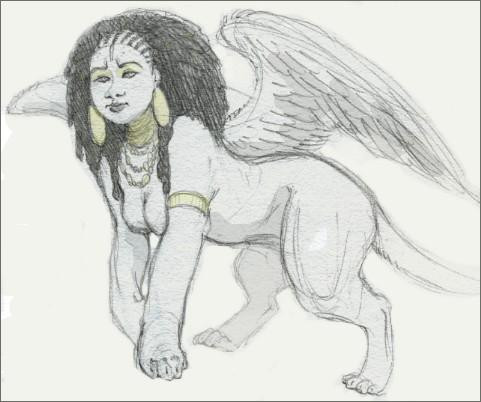HOME | DD
 thomastapir — Sphinx
thomastapir — Sphinx

Published: 2008-03-14 04:49:58 +0000 UTC; Views: 3268; Favourites: 53; Downloads: 43
Redirect to original
Description
This image is for a science fantasy project I'm working on with the premise that the "monsters" of classical world mythology are actually synthetic organisms left over from a vanished prehuman civilization, or perhaps a technological human culture lost to history. This being is actually a human heavily modified for interstellar travel. I pictured her returning to Earth after a failed colonization attempt to find her civilization long vanished. She patrols the abandoned ruins of an ancient city in North Africa, giving rise to the myth of the Sphinx.Related content
Comments: 8

Maybe the "What goes on four legs in the morning, two legs at noon and three at evening" is a reference to a race with three sages of development.
Say the first stage is a mindless, asexual larva, that is released into the wild to compete with nature for food and shelter. If the creature survives it slowly matures into its bipedal humanoid middle stage, like the Darwinian ascent of man. This stage finds itself a pack, usually picked up by scouts or blundering into camps. This stage is defined by it's physical ability and agility, serving as a hunter and scout for the "hive" or "Pack".
If the organism survives that stage, it matures into the last. The cranium bloats while the body atrophies, growing a third leg for stability. This stage serves as a repertoire of knowledge for the pack, using it's greater IQ and memory to remember routes and hunting grounds. The second stage, which has the intelligence of small child, obeys the third stage unquestioningly.
👍: 0 ⏩: 0

I totally would be that ... except with hooves..
👍: 0 ⏩: 1

NICE...I could see it. Wouldn't that be like a lamia or something?
👍: 0 ⏩: 1

Are those fangs protruding between the lips?
I'd have to ask, if it's not prying too much, what are its adaptations to interstellar travel and what mode did it use?
I was guessing most adaptations relate to microgravity (extra limbs for manoeuverability, "wings" to propel herself when stranded far from a wall) but I'm really at a loss here 
Anyway, I'd like to see the male sphinx, if there is any, to check the range of sexual dimorphism.
👍: 0 ⏩: 1

Those are very flat, 2D fangs protruding from the lips. : P They were kind of an afterthought, so the shape of the mouth doesn't really reflect the volume.
The main adaptations were supposed to be the ones you mentioned, as well as lighter bones. I kept going back and forth on whether the adaptations were for the journey itself or for the eventual destination...I know, it's a stretch to say she's adapted for interstellar travel, but my focus was more on the mythological aspect (making her look like a traditional sphinx), with the pseudo-scientific rationale for her appearance following secondarily from that.
I was also thinking of her culture as highly ritualistic, so her appearance may have as much to do with symbolism and aesthetics as with functionality. (It certainly does for me! ; ) Hmm, I kind of like that idea...The wings to indicate flying free of the Earth. The combined animal and human body to symbolize the progression from beast to man...Yeah, it's coming together now!
I didn't really have a strongly defined conception for the civilization's method of interstellar travel, although--keeping with the pseudo-science/"alternate history" aspect of the concept--I was picturing something involving gravity control, maybe along the lines of an alternate "Tesla physics" technology. I DID want the journey to be constrained by real-world physics in terms of the travel time and upper speed limit (

Hmm… I wonder: Are you familiar with the Orion’s Arm project? I think this would go right up their alley
Sphinxes could be adapted to live most of their life inside a starfaring habitat. Maybe the ritualistic character of the culture could be a way to cope with the inherent limited space and the long spells without visiting stellar systems. Or it could just have been a generation ship that went culturally bonkers. After all, that isn’t unheard of…
Lastly I’d like to apologize for the long time I took answering to your replies but I have coursework to do and I like to research my comments thoroughly
👍: 0 ⏩: 1

I've heard of Orion's Arm but I don't know much about it--from what I've heard it sounds like an amazing project! Gosh, none of your html links are coming through on my end recently. : /
I was thinking of the initial terrestrial culture as being highly ritualistic and ceremonial to begin with; I was modelling it on the Egyptians, Maya, and other such cultures steeped in the trappings of mythology and religious ceremony. As with Atlantis and other "lost continent" myths, I was thinking of those later megalithic human cultures as being derivative of this original civilization. But I also like that idea of the ritualistic aspects entailing a fabricated control system to provide social stability aboard a generational ship...The book "Captive Universe" by Harry Harrison plays on exactly that idea.
And hey, no problem on the delay in replies! You're under no obligation to respond, and I certainly understand about being busy. I appreciate the fact that you take the time to respond at all, and that you obviously put such research and consideration into your replies. Thanks for all your informative and thought-provoking feedback!
👍: 0 ⏩: 0



























